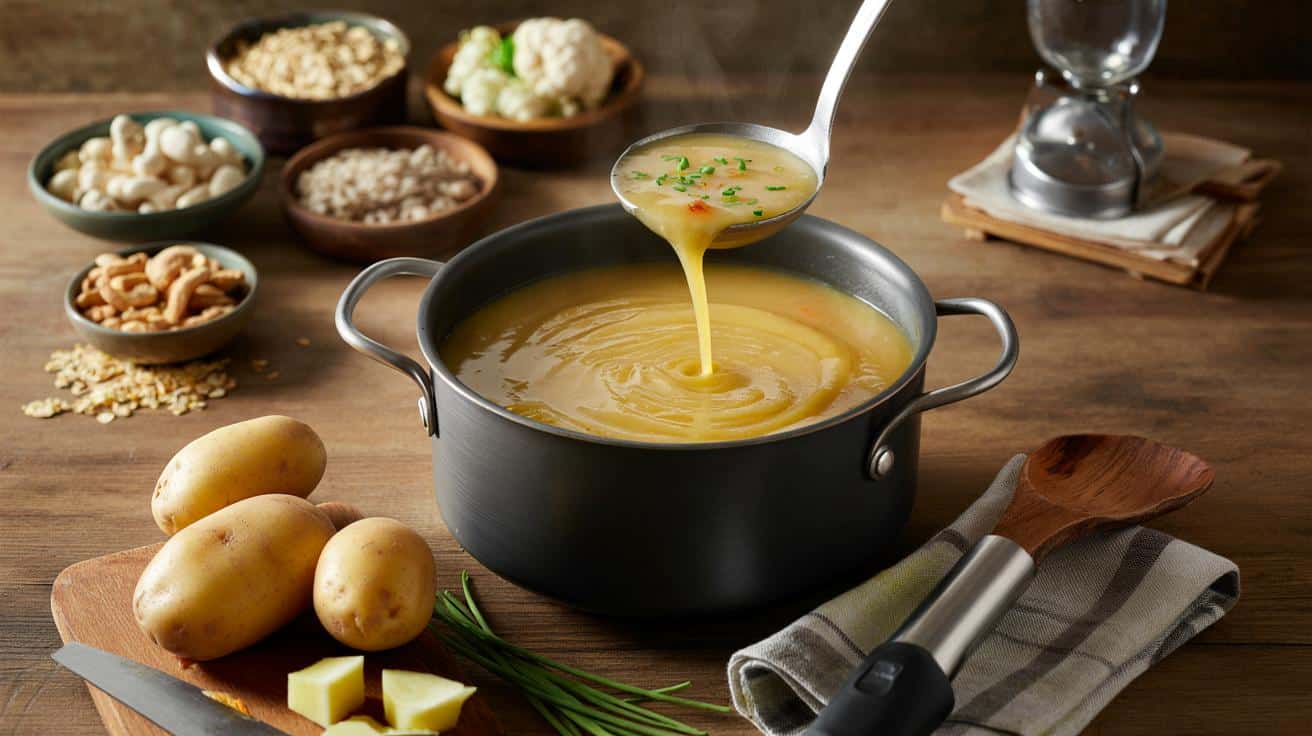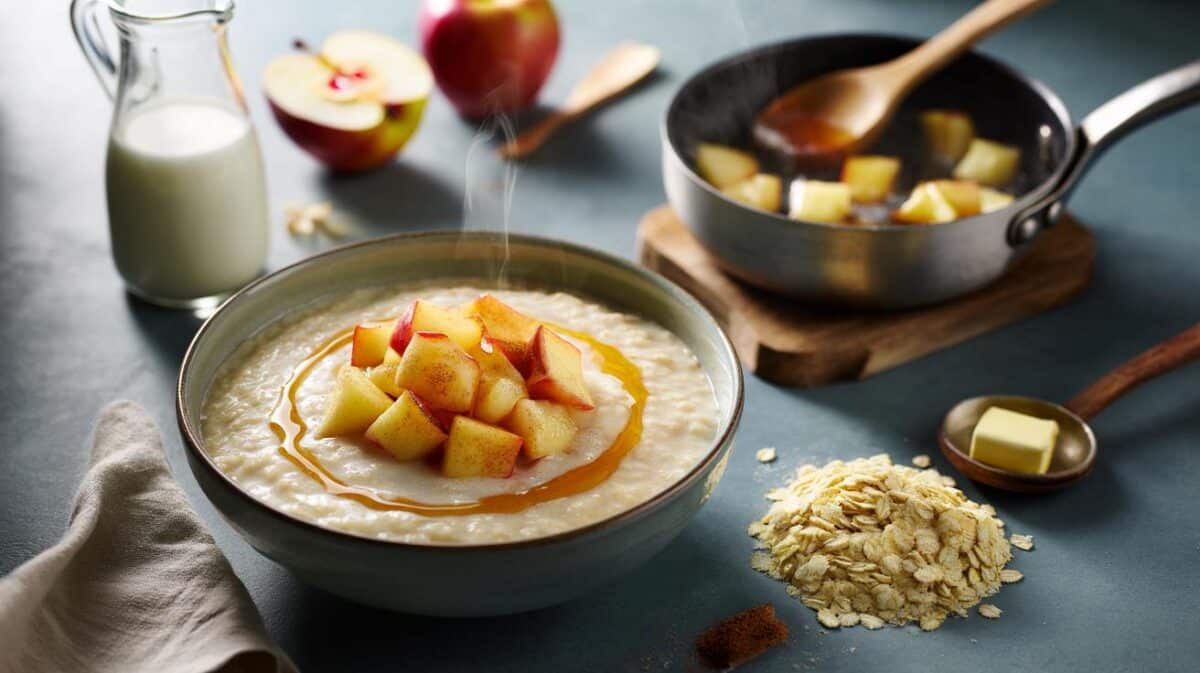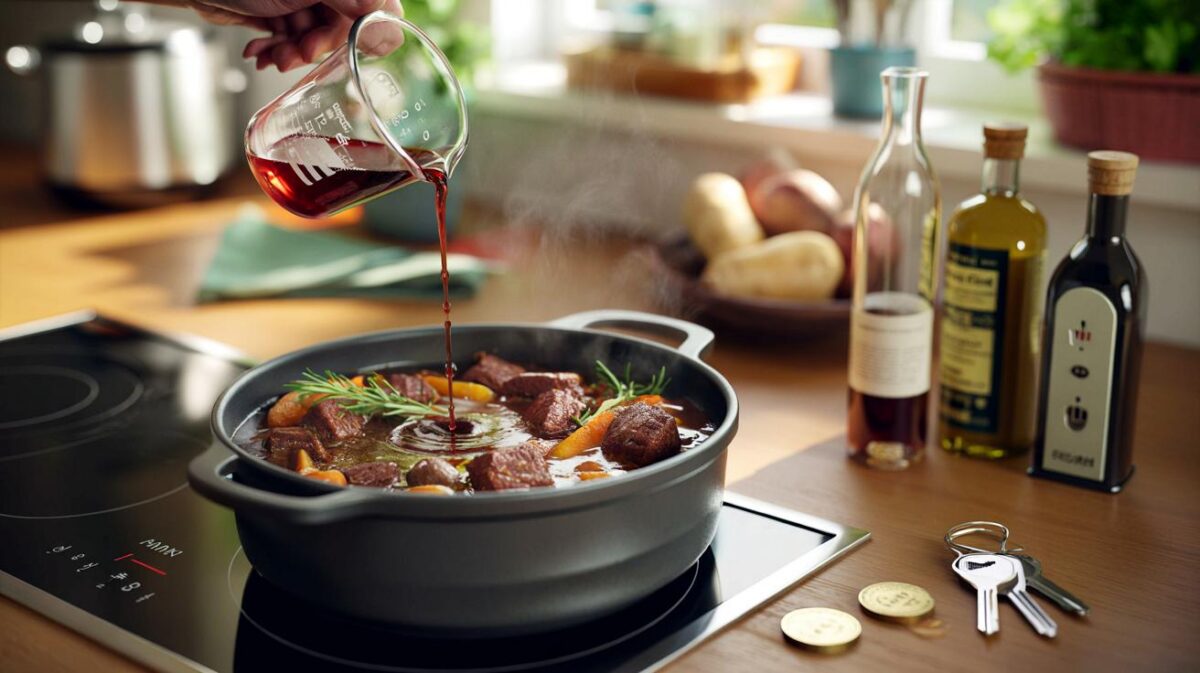Many home cooks want that restaurant gloss without cream or flour. Good news: there are fast, clever ways to build body, lock in flavour, and keep things light. With a couple of floury potatoes and a few store‑cupboard stand‑ins, you can turn a thin broth into a velvety bowl in minutes.
Why your soup turns thin
Thin soups often come from low starch content, watery vegetables, or too much stock. The fix is simple. Add natural thickeners that suspend in the liquid and create a gentle, creamy mouthfeel.
For each litre of soup, plan 150–250 g of starch‑rich vegetables or pulses to build proper body.
Potatoes: the fast route to silkiness
Choose the right spud
Floury potatoes release starch that thickens the pot as they cook. Maris Piper and King Edward are reliable picks. Waxy potatoes, such as Charlotte, Jersey Royals or new potatoes, hold their shape and add little thickness. Save those for salads.
Three ways to use them
- Dice-and-simmer: add 1 medium floury potato (about 200 g) per litre of soup. Simmer 15–20 minutes until soft, then mash a few cubes against the pan to release starch.
- Mash-and-stir: boil 250 g peeled floury potatoes separately, mash with a splash of cooking water, then whisk into the soup for immediate body.
- Blend-a-portion: ladle out 1–2 cups of the soup with the soft potato pieces, blend until smooth, and stir back in for a balanced texture.
Instant mash: the two‑minute cheat
Instant mashed potatoes deliver near‑instant thickness with clean control. Start small and build slowly.
Add 1 tablespoon of instant mash per 250 ml of soup, stir, wait 2–3 minutes, then reassess before adding more.
Check labels if you want a dairy‑free option, as some brands include milk powder. Season at the end, since potato soaks up salt.
Other flour‑free thickeners that work
Several everyday ingredients add creaminess without cream. Each brings a slightly different texture and flavour profile.
| Thickener | Why it works | How much per litre | Cook/blend time | Flavour impact |
|---|---|---|---|---|
| Cauliflower florets | Low‑calorie bulk; smooth when blended | 200–300 g | 15–18 min simmer; blend | Mild, slightly nutty |
| White beans (cannellini) | Starch and fibre; protein lift | 150–200 g drained | 5–10 min heat; blend | Gentle, savoury |
| Rolled oats | Beta‑glucans create body | 1–2 tbsp | 10–12 min simmer; optional blend | Lightly oaty |
| Red lentils | Break down to a creamy puree | 60–80 g | 15–20 min simmer | Earthy, warming |
| Cashews (soaked) | Natural emulsion; silky finish | 30–40 g | Soak 20 min; blend smooth | Rich, slightly sweet |
| Sweet potato | High pectin; smooth puree | 200–250 g | 15–20 min simmer; blend | Sweet, rounded |
Technique matters more than gadgets
Blend part, not all
Blending a portion gives creaminess while keeping some texture. Remove a ladle of solids, blitz with a little liquid, then return it to the pot. This adds body without turning everything into baby food.
Reduce gently
Simmer uncovered for 8–12 minutes to evaporate excess water. Stir often to stop sticking. Add salt after reducing, not before, to avoid an over‑salty finish.
Create a quick emulsion
A drizzle of olive oil whisked into the soup off the heat gives a glossy finish. Plain yoghurt also works in small amounts. Temper it first by stirring in warm soup, then add to the pan on low heat to avoid splitting.
Taste, cost and nutrition
Swapping cream for potato or beans trims calories and adds fibre. About 100 ml of double cream sits around 400–450 kcal. The same weight of potato lands near 70–80 kcal, and white beans around 90–110 kcal. The texture stays luxurious, while the bowl becomes more filling and better balanced.
From a budget angle, two Maris Pipers often cost less than a small tub of cream. Oats and red lentils are long‑life, low‑cost staples that thicken reliably and store well in airtight jars.
Target a nappe texture: the soup should lightly coat the back of a spoon, then fall in a smooth sheet.
Mistakes to avoid
- Over‑blending potatoes at high speed. This releases excess starch and turns the soup gluey. Pulse gently or mash by hand.
- Using waxy potatoes for thickening. They keep their shape and add little body.
- Adding too much instant mash at once. It swells after a short wait. Add gradually.
- Salting before reducing. Reduction concentrates salt. Adjust at the end.
- Not cooking oats long enough. Raw oats taste chalky. Give them time to soften.
- Stirring yoghurt into boiling soup. High heat causes curdling. Warm it first, add off the heat.
Make‑ahead thickening cubes
Batch‑cook a neutral base for busy weeks. Boil 500 g floury potatoes and 300 g cauliflower with a pinch of salt. Blend to a smooth puree with enough cooking water to loosen. Freeze in ice‑cube trays. Drop 2–3 cubes per litre into simmering soup for instant body. Label trays with date and ratios.
A quick template you can reuse tonight
Heat 1 tablespoon olive oil in a pot. Soften 1 onion and 1 carrot with a pinch of salt for 6–8 minutes. Add 2 cloves garlic and a spice of your choice for 30 seconds. Stir in 200 g floury potato cubes and your main vegetable. Pour in 1 litre hot stock. Simmer 18–22 minutes until soft. Blend a portion or mash a few cubes in the pan. Adjust thickness with 1–2 tablespoons instant mash or 150 g cooked white beans. Finish with lemon juice, chopped herbs and a drizzle of oil.
Extra context that helps you win the bowl
Starch science explains why this works. Potato starch granules swell and gel around 70–75°C, which thickens the liquid. Waxy varieties contain more amylopectin that holds shape, so they thicken less. Gentle heat preserves a silky finish. Vigorous blending bursts too many cells and can turn the texture pasty.
Dietary needs vary, so pick the thickener that suits your table. Beans and oats add fibre and plant protein. Cashews create a dairy‑free richness. Instant mash offers speed on a weeknight. Keep two strategies up your sleeve: a natural thickener in the pot and a small reduction at the end. That double move brings you to a smooth, spoon‑coating finish every time—no cream, no flour, no stress.









Tried the blend-a-portion trick tonight and wow, silky without cream. The “nappe” cue was gold. Any tips on keeping yogurt from curdling in spicy soups?
Not sold on instant mash—tastes a bit artificail to me. Would arrowroot or tapioca work here without getting that glossy, gloopy vibe? Curious where you’d land on that.